Business Transactions: Types, Users, and Financial Statements Report
VerifiedAdded on 2023/01/18
|18
|3692
|45
Report
AI Summary
This report provides a comprehensive overview of business transactions and financial reporting. It begins with a discussion of different types of business organizations, including sole proprietorships, partnerships, and corporations, highlighting the advantages of profit-based structures. The report then analyzes the main users of accounting information, categorizing them into internal (owners, management, employees) and external (creditors, investors, government, trading partners) users, and explaining how they utilize this information for decision-making. The report further delves into the uses of journals, ledgers, and financial statements to aid in understanding and interpreting financial data, with the goal of assisting users in making informed decisions about their investments. Overall, the report offers valuable insights into the fundamentals of business transactions and financial analysis.
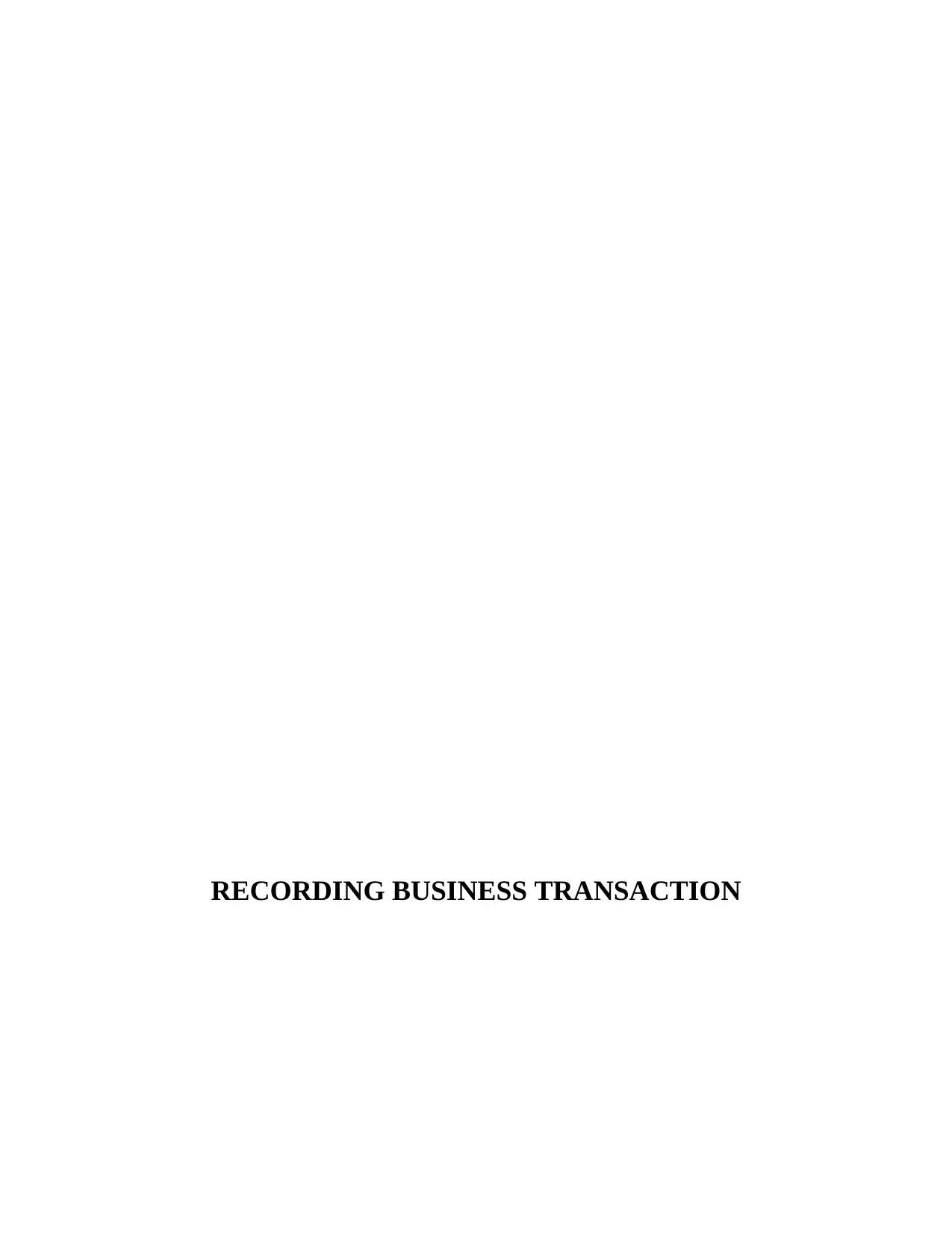
RECORDING BUSINESS TRANSACTION
Paraphrase This Document
Need a fresh take? Get an instant paraphrase of this document with our AI Paraphraser
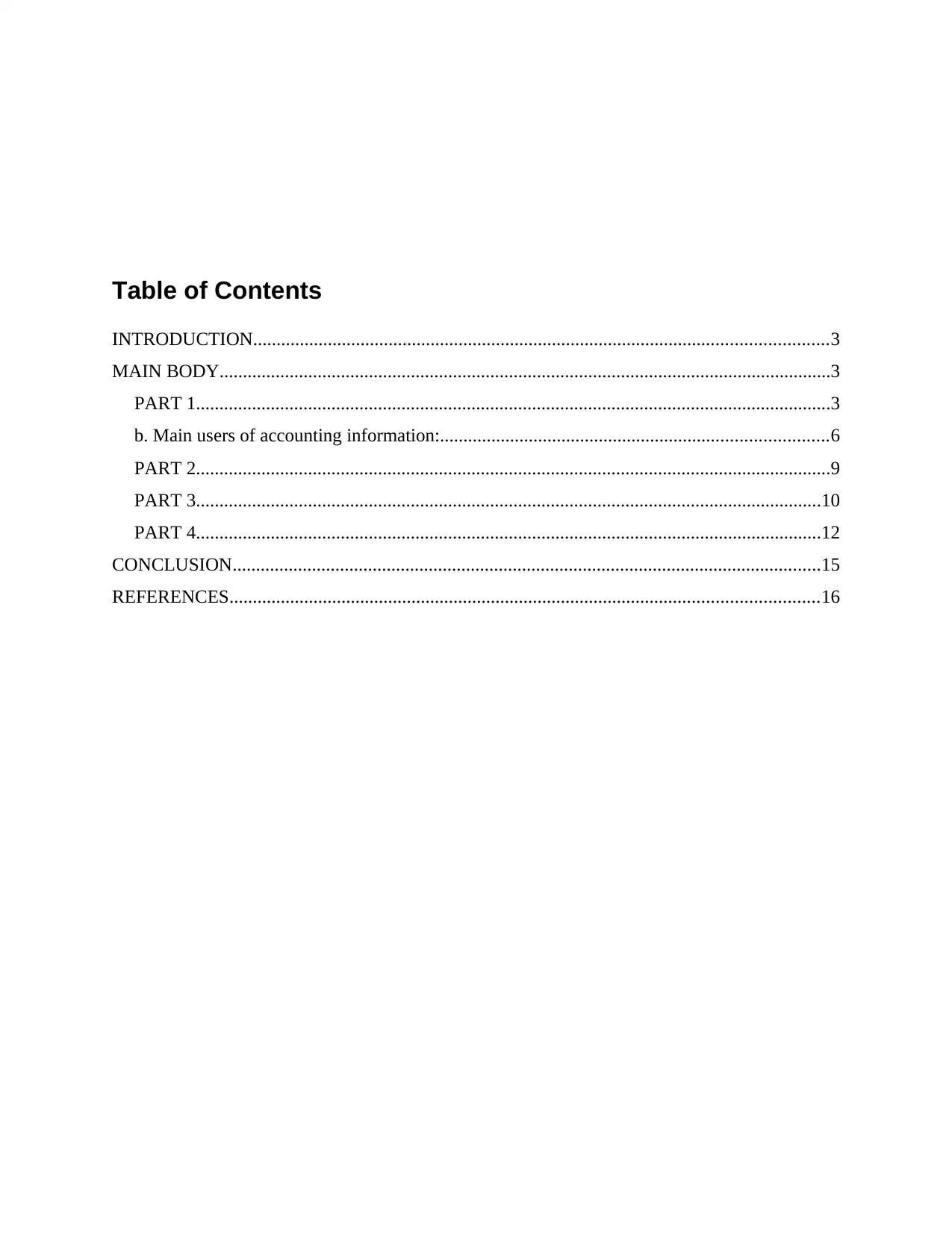
Table of Contents
INTRODUCTION...........................................................................................................................3
MAIN BODY...................................................................................................................................3
PART 1........................................................................................................................................3
b. Main users of accounting information:...................................................................................6
PART 2........................................................................................................................................9
PART 3......................................................................................................................................10
PART 4......................................................................................................................................12
CONCLUSION..............................................................................................................................15
REFERENCES..............................................................................................................................16
INTRODUCTION...........................................................................................................................3
MAIN BODY...................................................................................................................................3
PART 1........................................................................................................................................3
b. Main users of accounting information:...................................................................................6
PART 2........................................................................................................................................9
PART 3......................................................................................................................................10
PART 4......................................................................................................................................12
CONCLUSION..............................................................................................................................15
REFERENCES..............................................................................................................................16
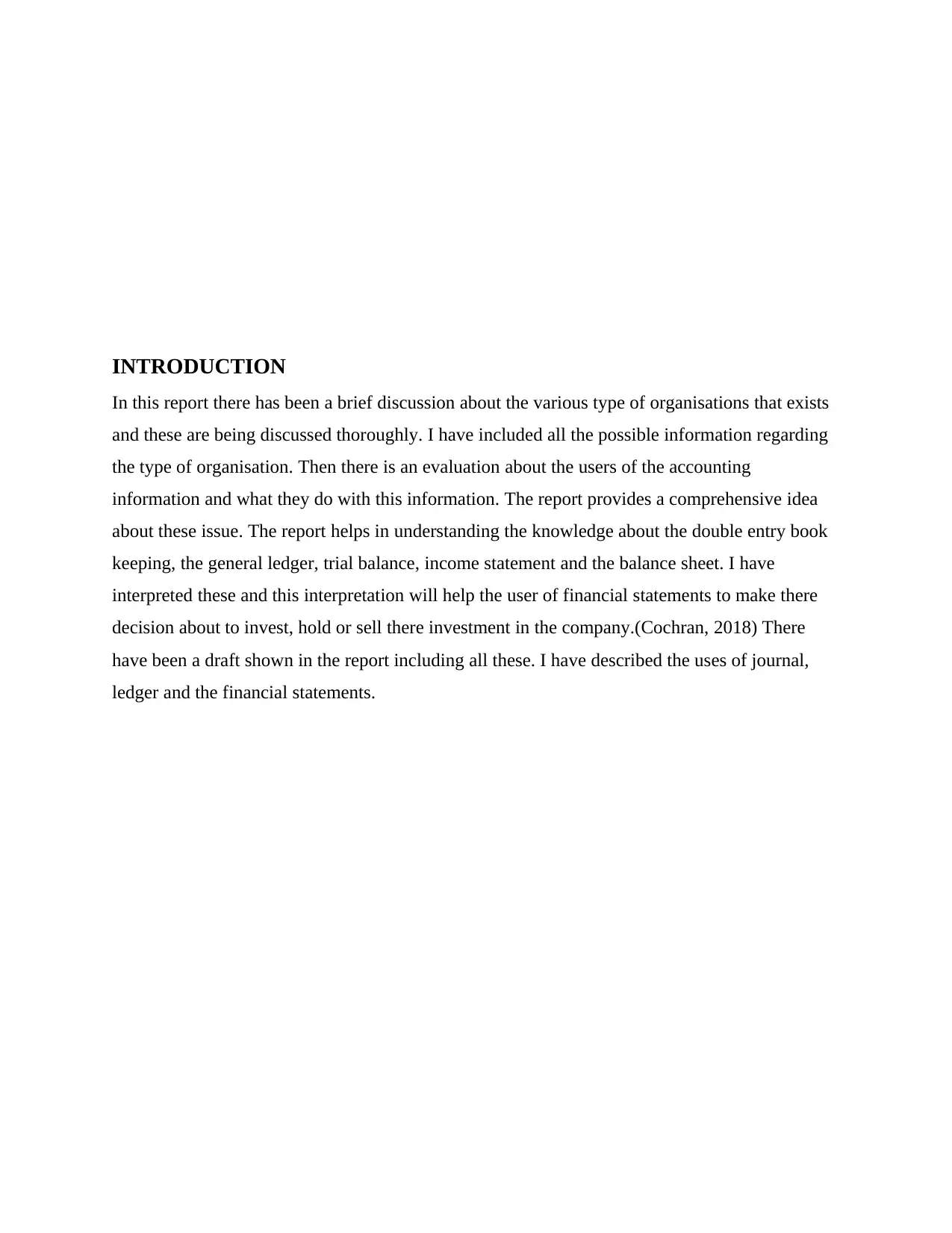
INTRODUCTION
In this report there has been a brief discussion about the various type of organisations that exists
and these are being discussed thoroughly. I have included all the possible information regarding
the type of organisation. Then there is an evaluation about the users of the accounting
information and what they do with this information. The report provides a comprehensive idea
about these issue. The report helps in understanding the knowledge about the double entry book
keeping, the general ledger, trial balance, income statement and the balance sheet. I have
interpreted these and this interpretation will help the user of financial statements to make there
decision about to invest, hold or sell there investment in the company.(Cochran, 2018) There
have been a draft shown in the report including all these. I have described the uses of journal,
ledger and the financial statements.
In this report there has been a brief discussion about the various type of organisations that exists
and these are being discussed thoroughly. I have included all the possible information regarding
the type of organisation. Then there is an evaluation about the users of the accounting
information and what they do with this information. The report provides a comprehensive idea
about these issue. The report helps in understanding the knowledge about the double entry book
keeping, the general ledger, trial balance, income statement and the balance sheet. I have
interpreted these and this interpretation will help the user of financial statements to make there
decision about to invest, hold or sell there investment in the company.(Cochran, 2018) There
have been a draft shown in the report including all these. I have described the uses of journal,
ledger and the financial statements.
⊘ This is a preview!⊘
Do you want full access?
Subscribe today to unlock all pages.

Trusted by 1+ million students worldwide
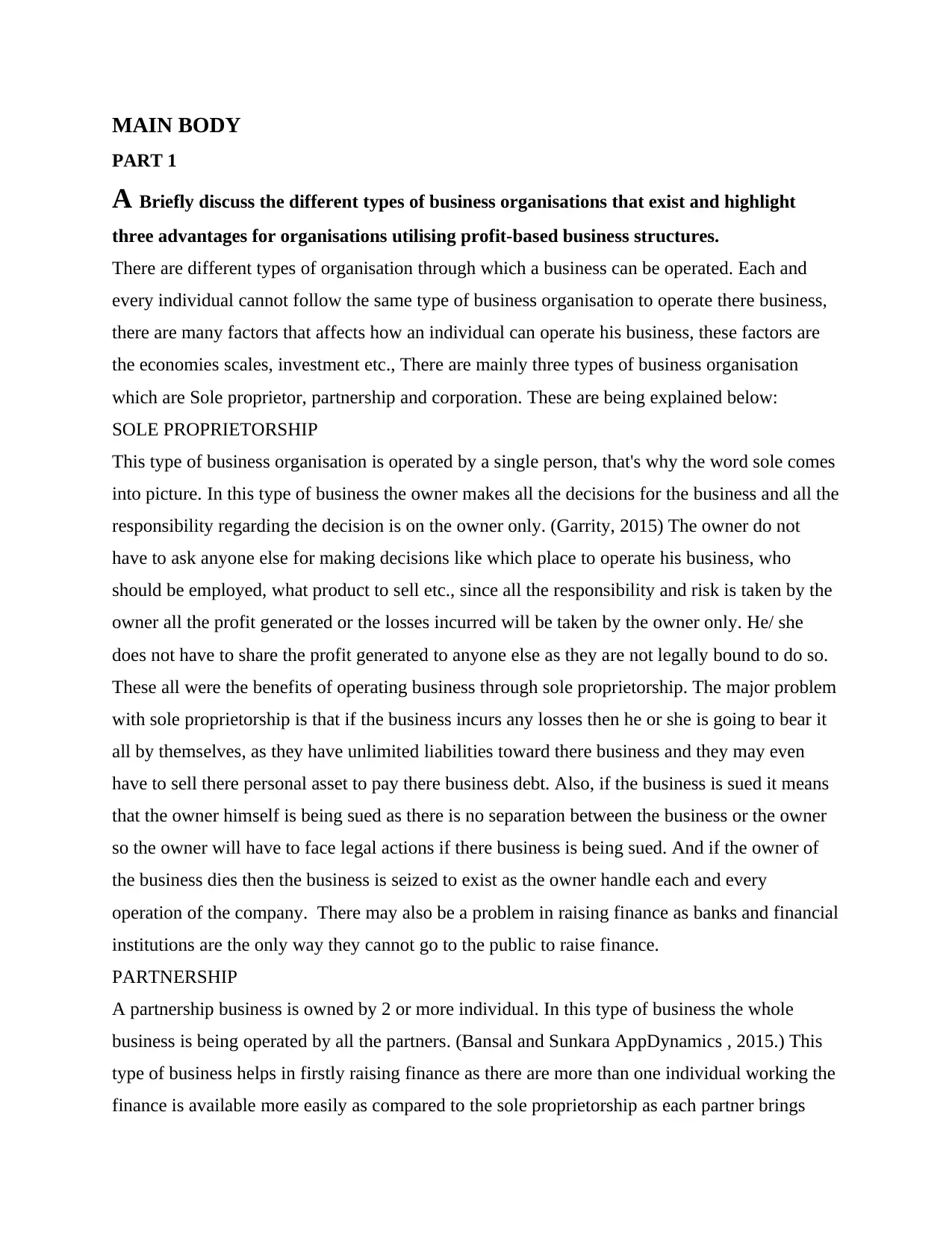
MAIN BODY
PART 1
A Briefly discuss the different types of business organisations that exist and highlight
three advantages for organisations utilising profit-based business structures.
There are different types of organisation through which a business can be operated. Each and
every individual cannot follow the same type of business organisation to operate there business,
there are many factors that affects how an individual can operate his business, these factors are
the economies scales, investment etc., There are mainly three types of business organisation
which are Sole proprietor, partnership and corporation. These are being explained below:
SOLE PROPRIETORSHIP
This type of business organisation is operated by a single person, that's why the word sole comes
into picture. In this type of business the owner makes all the decisions for the business and all the
responsibility regarding the decision is on the owner only. (Garrity, 2015) The owner do not
have to ask anyone else for making decisions like which place to operate his business, who
should be employed, what product to sell etc., since all the responsibility and risk is taken by the
owner all the profit generated or the losses incurred will be taken by the owner only. He/ she
does not have to share the profit generated to anyone else as they are not legally bound to do so.
These all were the benefits of operating business through sole proprietorship. The major problem
with sole proprietorship is that if the business incurs any losses then he or she is going to bear it
all by themselves, as they have unlimited liabilities toward there business and they may even
have to sell there personal asset to pay there business debt. Also, if the business is sued it means
that the owner himself is being sued as there is no separation between the business or the owner
so the owner will have to face legal actions if there business is being sued. And if the owner of
the business dies then the business is seized to exist as the owner handle each and every
operation of the company. There may also be a problem in raising finance as banks and financial
institutions are the only way they cannot go to the public to raise finance.
PARTNERSHIP
A partnership business is owned by 2 or more individual. In this type of business the whole
business is being operated by all the partners. (Bansal and Sunkara AppDynamics , 2015.) This
type of business helps in firstly raising finance as there are more than one individual working the
finance is available more easily as compared to the sole proprietorship as each partner brings
PART 1
A Briefly discuss the different types of business organisations that exist and highlight
three advantages for organisations utilising profit-based business structures.
There are different types of organisation through which a business can be operated. Each and
every individual cannot follow the same type of business organisation to operate there business,
there are many factors that affects how an individual can operate his business, these factors are
the economies scales, investment etc., There are mainly three types of business organisation
which are Sole proprietor, partnership and corporation. These are being explained below:
SOLE PROPRIETORSHIP
This type of business organisation is operated by a single person, that's why the word sole comes
into picture. In this type of business the owner makes all the decisions for the business and all the
responsibility regarding the decision is on the owner only. (Garrity, 2015) The owner do not
have to ask anyone else for making decisions like which place to operate his business, who
should be employed, what product to sell etc., since all the responsibility and risk is taken by the
owner all the profit generated or the losses incurred will be taken by the owner only. He/ she
does not have to share the profit generated to anyone else as they are not legally bound to do so.
These all were the benefits of operating business through sole proprietorship. The major problem
with sole proprietorship is that if the business incurs any losses then he or she is going to bear it
all by themselves, as they have unlimited liabilities toward there business and they may even
have to sell there personal asset to pay there business debt. Also, if the business is sued it means
that the owner himself is being sued as there is no separation between the business or the owner
so the owner will have to face legal actions if there business is being sued. And if the owner of
the business dies then the business is seized to exist as the owner handle each and every
operation of the company. There may also be a problem in raising finance as banks and financial
institutions are the only way they cannot go to the public to raise finance.
PARTNERSHIP
A partnership business is owned by 2 or more individual. In this type of business the whole
business is being operated by all the partners. (Bansal and Sunkara AppDynamics , 2015.) This
type of business helps in firstly raising finance as there are more than one individual working the
finance is available more easily as compared to the sole proprietorship as each partner brings
Paraphrase This Document
Need a fresh take? Get an instant paraphrase of this document with our AI Paraphraser
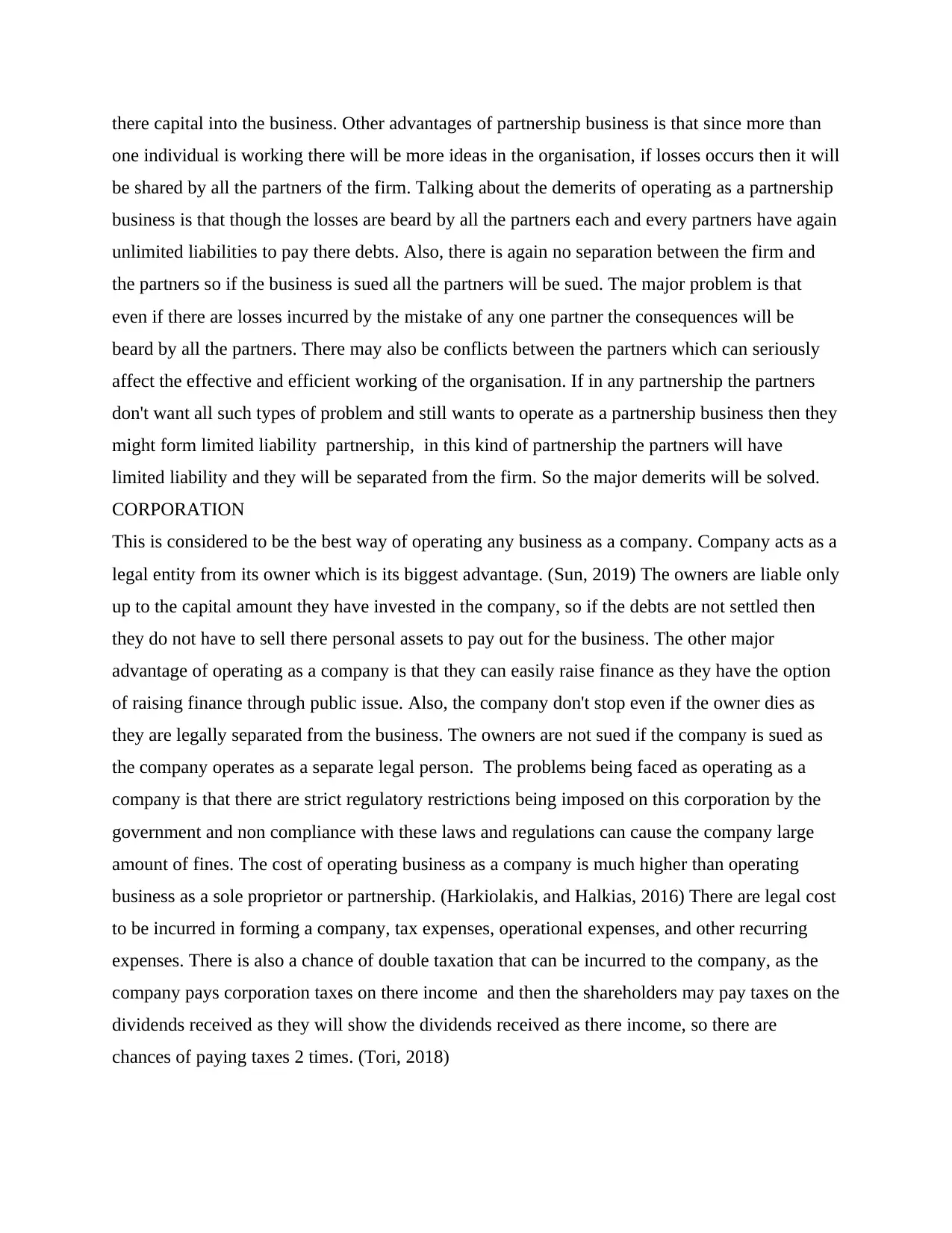
there capital into the business. Other advantages of partnership business is that since more than
one individual is working there will be more ideas in the organisation, if losses occurs then it will
be shared by all the partners of the firm. Talking about the demerits of operating as a partnership
business is that though the losses are beard by all the partners each and every partners have again
unlimited liabilities to pay there debts. Also, there is again no separation between the firm and
the partners so if the business is sued all the partners will be sued. The major problem is that
even if there are losses incurred by the mistake of any one partner the consequences will be
beard by all the partners. There may also be conflicts between the partners which can seriously
affect the effective and efficient working of the organisation. If in any partnership the partners
don't want all such types of problem and still wants to operate as a partnership business then they
might form limited liability partnership, in this kind of partnership the partners will have
limited liability and they will be separated from the firm. So the major demerits will be solved.
CORPORATION
This is considered to be the best way of operating any business as a company. Company acts as a
legal entity from its owner which is its biggest advantage. (Sun, 2019) The owners are liable only
up to the capital amount they have invested in the company, so if the debts are not settled then
they do not have to sell there personal assets to pay out for the business. The other major
advantage of operating as a company is that they can easily raise finance as they have the option
of raising finance through public issue. Also, the company don't stop even if the owner dies as
they are legally separated from the business. The owners are not sued if the company is sued as
the company operates as a separate legal person. The problems being faced as operating as a
company is that there are strict regulatory restrictions being imposed on this corporation by the
government and non compliance with these laws and regulations can cause the company large
amount of fines. The cost of operating business as a company is much higher than operating
business as a sole proprietor or partnership. (Harkiolakis, and Halkias, 2016) There are legal cost
to be incurred in forming a company, tax expenses, operational expenses, and other recurring
expenses. There is also a chance of double taxation that can be incurred to the company, as the
company pays corporation taxes on there income and then the shareholders may pay taxes on the
dividends received as they will show the dividends received as there income, so there are
chances of paying taxes 2 times. (Tori, 2018)
one individual is working there will be more ideas in the organisation, if losses occurs then it will
be shared by all the partners of the firm. Talking about the demerits of operating as a partnership
business is that though the losses are beard by all the partners each and every partners have again
unlimited liabilities to pay there debts. Also, there is again no separation between the firm and
the partners so if the business is sued all the partners will be sued. The major problem is that
even if there are losses incurred by the mistake of any one partner the consequences will be
beard by all the partners. There may also be conflicts between the partners which can seriously
affect the effective and efficient working of the organisation. If in any partnership the partners
don't want all such types of problem and still wants to operate as a partnership business then they
might form limited liability partnership, in this kind of partnership the partners will have
limited liability and they will be separated from the firm. So the major demerits will be solved.
CORPORATION
This is considered to be the best way of operating any business as a company. Company acts as a
legal entity from its owner which is its biggest advantage. (Sun, 2019) The owners are liable only
up to the capital amount they have invested in the company, so if the debts are not settled then
they do not have to sell there personal assets to pay out for the business. The other major
advantage of operating as a company is that they can easily raise finance as they have the option
of raising finance through public issue. Also, the company don't stop even if the owner dies as
they are legally separated from the business. The owners are not sued if the company is sued as
the company operates as a separate legal person. The problems being faced as operating as a
company is that there are strict regulatory restrictions being imposed on this corporation by the
government and non compliance with these laws and regulations can cause the company large
amount of fines. The cost of operating business as a company is much higher than operating
business as a sole proprietor or partnership. (Harkiolakis, and Halkias, 2016) There are legal cost
to be incurred in forming a company, tax expenses, operational expenses, and other recurring
expenses. There is also a chance of double taxation that can be incurred to the company, as the
company pays corporation taxes on there income and then the shareholders may pay taxes on the
dividends received as they will show the dividends received as there income, so there are
chances of paying taxes 2 times. (Tori, 2018)
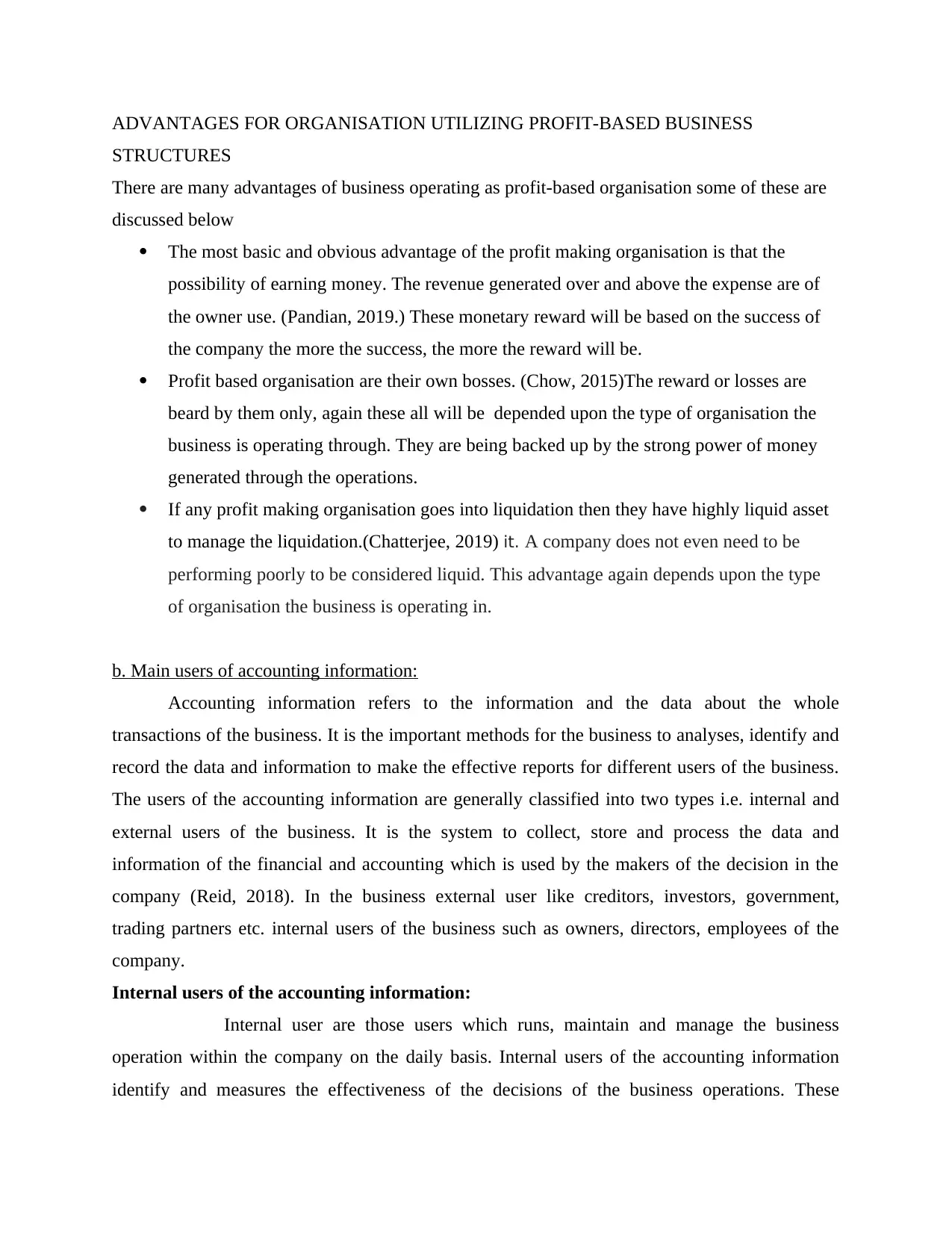
ADVANTAGES FOR ORGANISATION UTILIZING PROFIT-BASED BUSINESS
STRUCTURES
There are many advantages of business operating as profit-based organisation some of these are
discussed below
The most basic and obvious advantage of the profit making organisation is that the
possibility of earning money. The revenue generated over and above the expense are of
the owner use. (Pandian, 2019.) These monetary reward will be based on the success of
the company the more the success, the more the reward will be.
Profit based organisation are their own bosses. (Chow, 2015)The reward or losses are
beard by them only, again these all will be depended upon the type of organisation the
business is operating through. They are being backed up by the strong power of money
generated through the operations.
If any profit making organisation goes into liquidation then they have highly liquid asset
to manage the liquidation.(Chatterjee, 2019) it. A company does not even need to be
performing poorly to be considered liquid. This advantage again depends upon the type
of organisation the business is operating in.
b. Main users of accounting information:
Accounting information refers to the information and the data about the whole
transactions of the business. It is the important methods for the business to analyses, identify and
record the data and information to make the effective reports for different users of the business.
The users of the accounting information are generally classified into two types i.e. internal and
external users of the business. It is the system to collect, store and process the data and
information of the financial and accounting which is used by the makers of the decision in the
company (Reid, 2018). In the business external user like creditors, investors, government,
trading partners etc. internal users of the business such as owners, directors, employees of the
company.
Internal users of the accounting information:
Internal user are those users which runs, maintain and manage the business
operation within the company on the daily basis. Internal users of the accounting information
identify and measures the effectiveness of the decisions of the business operations. These
STRUCTURES
There are many advantages of business operating as profit-based organisation some of these are
discussed below
The most basic and obvious advantage of the profit making organisation is that the
possibility of earning money. The revenue generated over and above the expense are of
the owner use. (Pandian, 2019.) These monetary reward will be based on the success of
the company the more the success, the more the reward will be.
Profit based organisation are their own bosses. (Chow, 2015)The reward or losses are
beard by them only, again these all will be depended upon the type of organisation the
business is operating through. They are being backed up by the strong power of money
generated through the operations.
If any profit making organisation goes into liquidation then they have highly liquid asset
to manage the liquidation.(Chatterjee, 2019) it. A company does not even need to be
performing poorly to be considered liquid. This advantage again depends upon the type
of organisation the business is operating in.
b. Main users of accounting information:
Accounting information refers to the information and the data about the whole
transactions of the business. It is the important methods for the business to analyses, identify and
record the data and information to make the effective reports for different users of the business.
The users of the accounting information are generally classified into two types i.e. internal and
external users of the business. It is the system to collect, store and process the data and
information of the financial and accounting which is used by the makers of the decision in the
company (Reid, 2018). In the business external user like creditors, investors, government,
trading partners etc. internal users of the business such as owners, directors, employees of the
company.
Internal users of the accounting information:
Internal user are those users which runs, maintain and manage the business
operation within the company on the daily basis. Internal users of the accounting information
identify and measures the effectiveness of the decisions of the business operations. These
⊘ This is a preview!⊘
Do you want full access?
Subscribe today to unlock all pages.

Trusted by 1+ million students worldwide
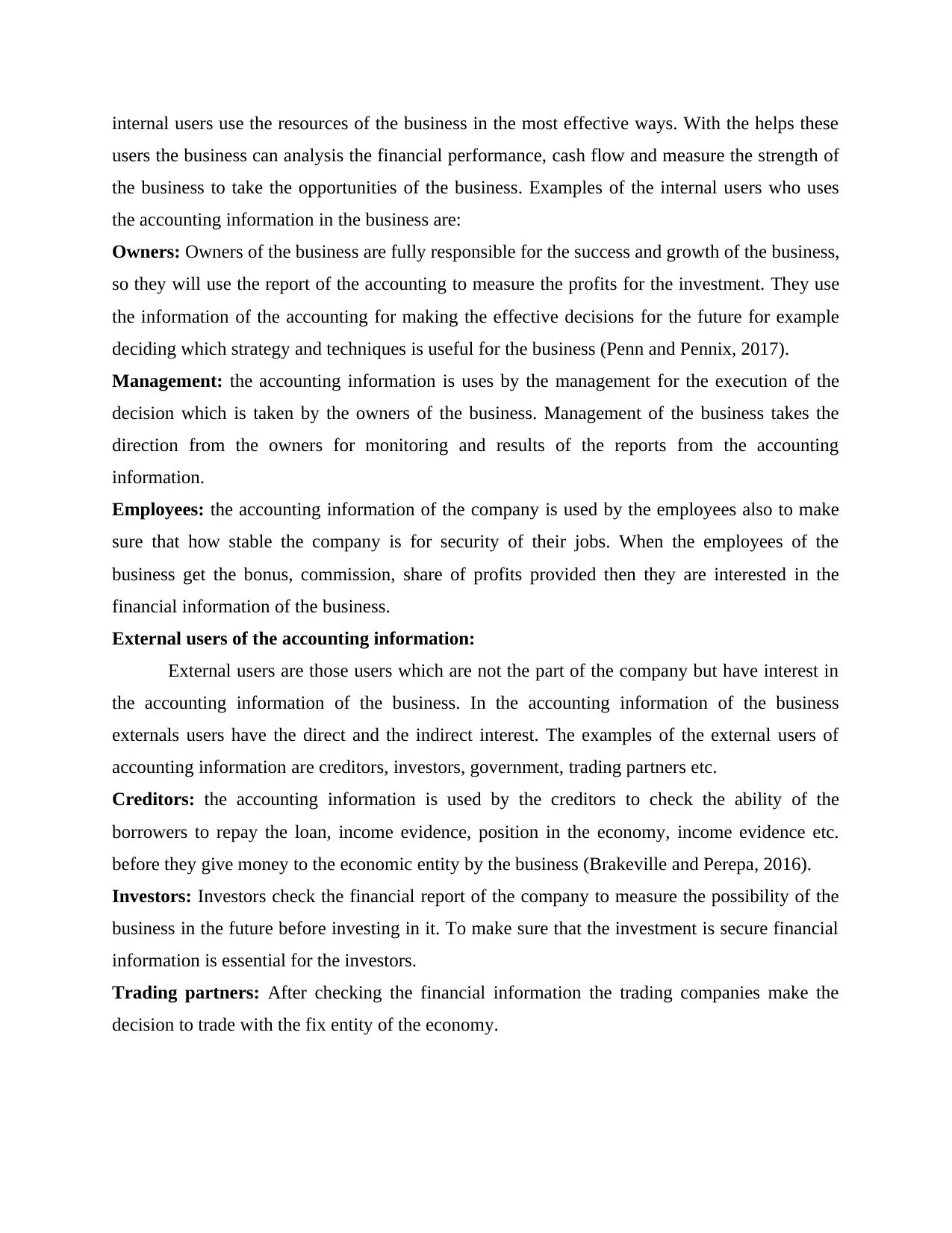
internal users use the resources of the business in the most effective ways. With the helps these
users the business can analysis the financial performance, cash flow and measure the strength of
the business to take the opportunities of the business. Examples of the internal users who uses
the accounting information in the business are:
Owners: Owners of the business are fully responsible for the success and growth of the business,
so they will use the report of the accounting to measure the profits for the investment. They use
the information of the accounting for making the effective decisions for the future for example
deciding which strategy and techniques is useful for the business (Penn and Pennix, 2017).
Management: the accounting information is uses by the management for the execution of the
decision which is taken by the owners of the business. Management of the business takes the
direction from the owners for monitoring and results of the reports from the accounting
information.
Employees: the accounting information of the company is used by the employees also to make
sure that how stable the company is for security of their jobs. When the employees of the
business get the bonus, commission, share of profits provided then they are interested in the
financial information of the business.
External users of the accounting information:
External users are those users which are not the part of the company but have interest in
the accounting information of the business. In the accounting information of the business
externals users have the direct and the indirect interest. The examples of the external users of
accounting information are creditors, investors, government, trading partners etc.
Creditors: the accounting information is used by the creditors to check the ability of the
borrowers to repay the loan, income evidence, position in the economy, income evidence etc.
before they give money to the economic entity by the business (Brakeville and Perepa, 2016).
Investors: Investors check the financial report of the company to measure the possibility of the
business in the future before investing in it. To make sure that the investment is secure financial
information is essential for the investors.
Trading partners: After checking the financial information the trading companies make the
decision to trade with the fix entity of the economy.
users the business can analysis the financial performance, cash flow and measure the strength of
the business to take the opportunities of the business. Examples of the internal users who uses
the accounting information in the business are:
Owners: Owners of the business are fully responsible for the success and growth of the business,
so they will use the report of the accounting to measure the profits for the investment. They use
the information of the accounting for making the effective decisions for the future for example
deciding which strategy and techniques is useful for the business (Penn and Pennix, 2017).
Management: the accounting information is uses by the management for the execution of the
decision which is taken by the owners of the business. Management of the business takes the
direction from the owners for monitoring and results of the reports from the accounting
information.
Employees: the accounting information of the company is used by the employees also to make
sure that how stable the company is for security of their jobs. When the employees of the
business get the bonus, commission, share of profits provided then they are interested in the
financial information of the business.
External users of the accounting information:
External users are those users which are not the part of the company but have interest in
the accounting information of the business. In the accounting information of the business
externals users have the direct and the indirect interest. The examples of the external users of
accounting information are creditors, investors, government, trading partners etc.
Creditors: the accounting information is used by the creditors to check the ability of the
borrowers to repay the loan, income evidence, position in the economy, income evidence etc.
before they give money to the economic entity by the business (Brakeville and Perepa, 2016).
Investors: Investors check the financial report of the company to measure the possibility of the
business in the future before investing in it. To make sure that the investment is secure financial
information is essential for the investors.
Trading partners: After checking the financial information the trading companies make the
decision to trade with the fix entity of the economy.
Paraphrase This Document
Need a fresh take? Get an instant paraphrase of this document with our AI Paraphraser
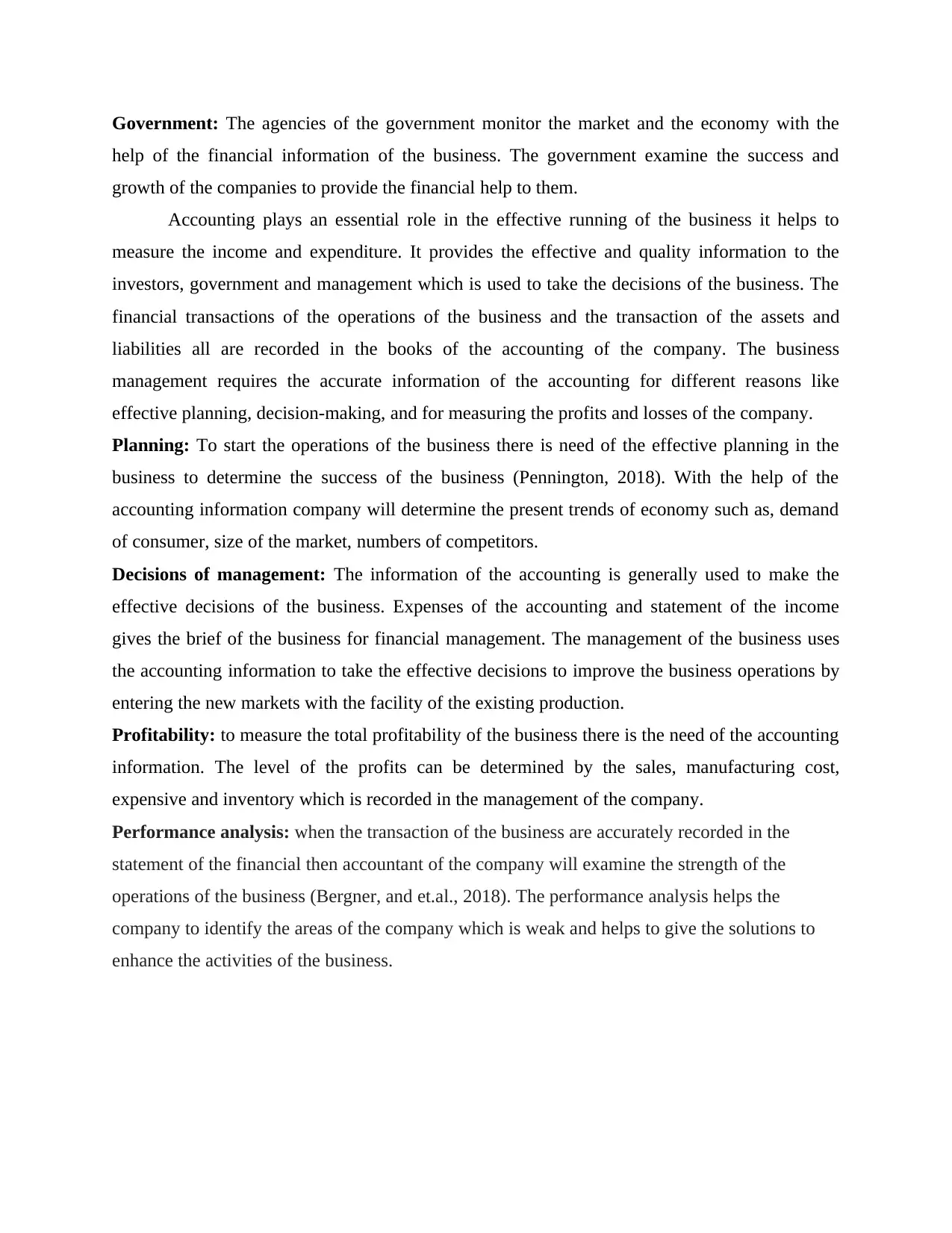
Government: The agencies of the government monitor the market and the economy with the
help of the financial information of the business. The government examine the success and
growth of the companies to provide the financial help to them.
Accounting plays an essential role in the effective running of the business it helps to
measure the income and expenditure. It provides the effective and quality information to the
investors, government and management which is used to take the decisions of the business. The
financial transactions of the operations of the business and the transaction of the assets and
liabilities all are recorded in the books of the accounting of the company. The business
management requires the accurate information of the accounting for different reasons like
effective planning, decision-making, and for measuring the profits and losses of the company.
Planning: To start the operations of the business there is need of the effective planning in the
business to determine the success of the business (Pennington, 2018). With the help of the
accounting information company will determine the present trends of economy such as, demand
of consumer, size of the market, numbers of competitors.
Decisions of management: The information of the accounting is generally used to make the
effective decisions of the business. Expenses of the accounting and statement of the income
gives the brief of the business for financial management. The management of the business uses
the accounting information to take the effective decisions to improve the business operations by
entering the new markets with the facility of the existing production.
Profitability: to measure the total profitability of the business there is the need of the accounting
information. The level of the profits can be determined by the sales, manufacturing cost,
expensive and inventory which is recorded in the management of the company.
Performance analysis: when the transaction of the business are accurately recorded in the
statement of the financial then accountant of the company will examine the strength of the
operations of the business (Bergner, and et.al., 2018). The performance analysis helps the
company to identify the areas of the company which is weak and helps to give the solutions to
enhance the activities of the business.
help of the financial information of the business. The government examine the success and
growth of the companies to provide the financial help to them.
Accounting plays an essential role in the effective running of the business it helps to
measure the income and expenditure. It provides the effective and quality information to the
investors, government and management which is used to take the decisions of the business. The
financial transactions of the operations of the business and the transaction of the assets and
liabilities all are recorded in the books of the accounting of the company. The business
management requires the accurate information of the accounting for different reasons like
effective planning, decision-making, and for measuring the profits and losses of the company.
Planning: To start the operations of the business there is need of the effective planning in the
business to determine the success of the business (Pennington, 2018). With the help of the
accounting information company will determine the present trends of economy such as, demand
of consumer, size of the market, numbers of competitors.
Decisions of management: The information of the accounting is generally used to make the
effective decisions of the business. Expenses of the accounting and statement of the income
gives the brief of the business for financial management. The management of the business uses
the accounting information to take the effective decisions to improve the business operations by
entering the new markets with the facility of the existing production.
Profitability: to measure the total profitability of the business there is the need of the accounting
information. The level of the profits can be determined by the sales, manufacturing cost,
expensive and inventory which is recorded in the management of the company.
Performance analysis: when the transaction of the business are accurately recorded in the
statement of the financial then accountant of the company will examine the strength of the
operations of the business (Bergner, and et.al., 2018). The performance analysis helps the
company to identify the areas of the company which is weak and helps to give the solutions to
enhance the activities of the business.
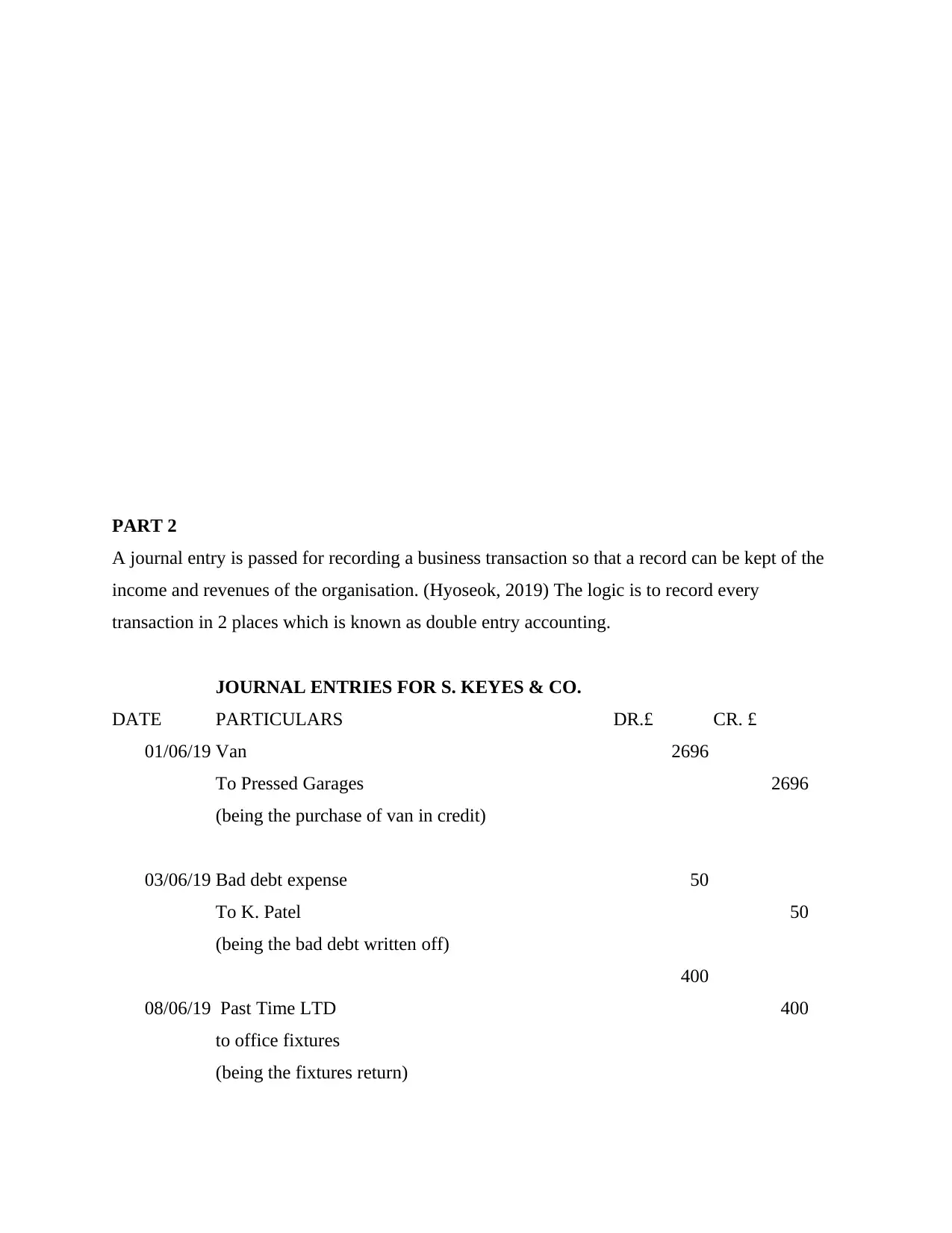
PART 2
A journal entry is passed for recording a business transaction so that a record can be kept of the
income and revenues of the organisation. (Hyoseok, 2019) The logic is to record every
transaction in 2 places which is known as double entry accounting.
JOURNAL ENTRIES FOR S. KEYES & CO.
DATE PARTICULARS DR.£ CR. £
01/06/19 Van 2696
To Pressed Garages 2696
(being the purchase of van in credit)
03/06/19 Bad debt expense 50
To K. Patel 50
(being the bad debt written off)
400
08/06/19 Past Time LTD 400
to office fixtures
(being the fixtures return)
A journal entry is passed for recording a business transaction so that a record can be kept of the
income and revenues of the organisation. (Hyoseok, 2019) The logic is to record every
transaction in 2 places which is known as double entry accounting.
JOURNAL ENTRIES FOR S. KEYES & CO.
DATE PARTICULARS DR.£ CR. £
01/06/19 Van 2696
To Pressed Garages 2696
(being the purchase of van in credit)
03/06/19 Bad debt expense 50
To K. Patel 50
(being the bad debt written off)
400
08/06/19 Past Time LTD 400
to office fixtures
(being the fixtures return)
⊘ This is a preview!⊘
Do you want full access?
Subscribe today to unlock all pages.

Trusted by 1+ million students worldwide
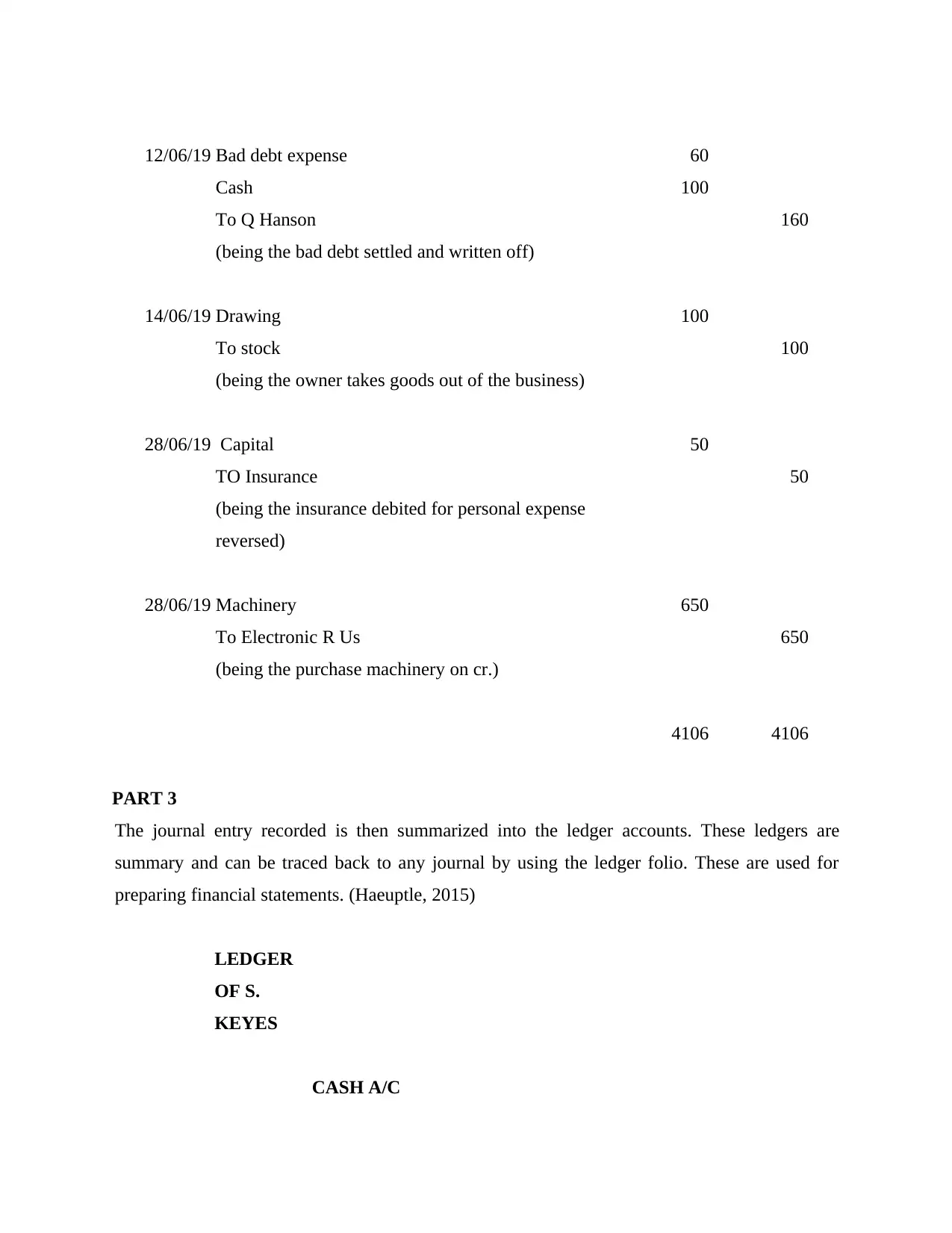
12/06/19 Bad debt expense 60
Cash 100
To Q Hanson 160
(being the bad debt settled and written off)
14/06/19 Drawing 100
To stock 100
(being the owner takes goods out of the business)
28/06/19 Capital 50
TO Insurance 50
(being the insurance debited for personal expense
reversed)
28/06/19 Machinery 650
To Electronic R Us 650
(being the purchase machinery on cr.)
4106 4106
PART 3
The journal entry recorded is then summarized into the ledger accounts. These ledgers are
summary and can be traced back to any journal by using the ledger folio. These are used for
preparing financial statements. (Haeuptle, 2015)
LEDGER
OF S.
KEYES
CASH A/C
Cash 100
To Q Hanson 160
(being the bad debt settled and written off)
14/06/19 Drawing 100
To stock 100
(being the owner takes goods out of the business)
28/06/19 Capital 50
TO Insurance 50
(being the insurance debited for personal expense
reversed)
28/06/19 Machinery 650
To Electronic R Us 650
(being the purchase machinery on cr.)
4106 4106
PART 3
The journal entry recorded is then summarized into the ledger accounts. These ledgers are
summary and can be traced back to any journal by using the ledger folio. These are used for
preparing financial statements. (Haeuptle, 2015)
LEDGER
OF S.
KEYES
CASH A/C
Paraphrase This Document
Need a fresh take? Get an instant paraphrase of this document with our AI Paraphraser
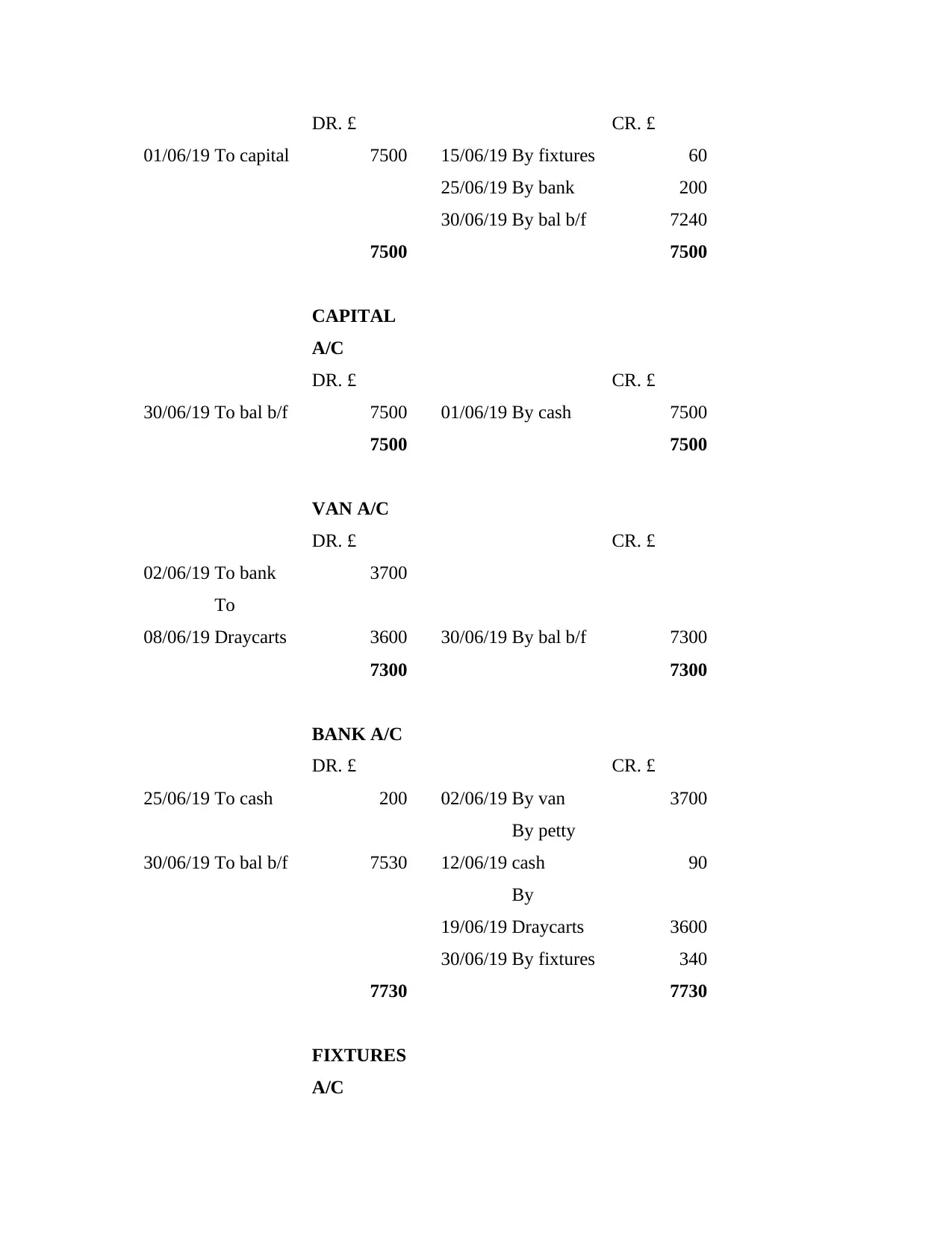
DR. £ CR. £
01/06/19 To capital 7500 15/06/19 By fixtures 60
25/06/19 By bank 200
30/06/19 By bal b/f 7240
7500 7500
CAPITAL
A/C
DR. £ CR. £
30/06/19 To bal b/f 7500 01/06/19 By cash 7500
7500 7500
VAN A/C
DR. £ CR. £
02/06/19 To bank 3700
08/06/19
To
Draycarts 3600 30/06/19 By bal b/f 7300
7300 7300
BANK A/C
DR. £ CR. £
25/06/19 To cash 200 02/06/19 By van 3700
30/06/19 To bal b/f 7530 12/06/19
By petty
cash 90
19/06/19
By
Draycarts 3600
30/06/19 By fixtures 340
7730 7730
FIXTURES
A/C
01/06/19 To capital 7500 15/06/19 By fixtures 60
25/06/19 By bank 200
30/06/19 By bal b/f 7240
7500 7500
CAPITAL
A/C
DR. £ CR. £
30/06/19 To bal b/f 7500 01/06/19 By cash 7500
7500 7500
VAN A/C
DR. £ CR. £
02/06/19 To bank 3700
08/06/19
To
Draycarts 3600 30/06/19 By bal b/f 7300
7300 7300
BANK A/C
DR. £ CR. £
25/06/19 To cash 200 02/06/19 By van 3700
30/06/19 To bal b/f 7530 12/06/19
By petty
cash 90
19/06/19
By
Draycarts 3600
30/06/19 By fixtures 340
7730 7730
FIXTURES
A/C
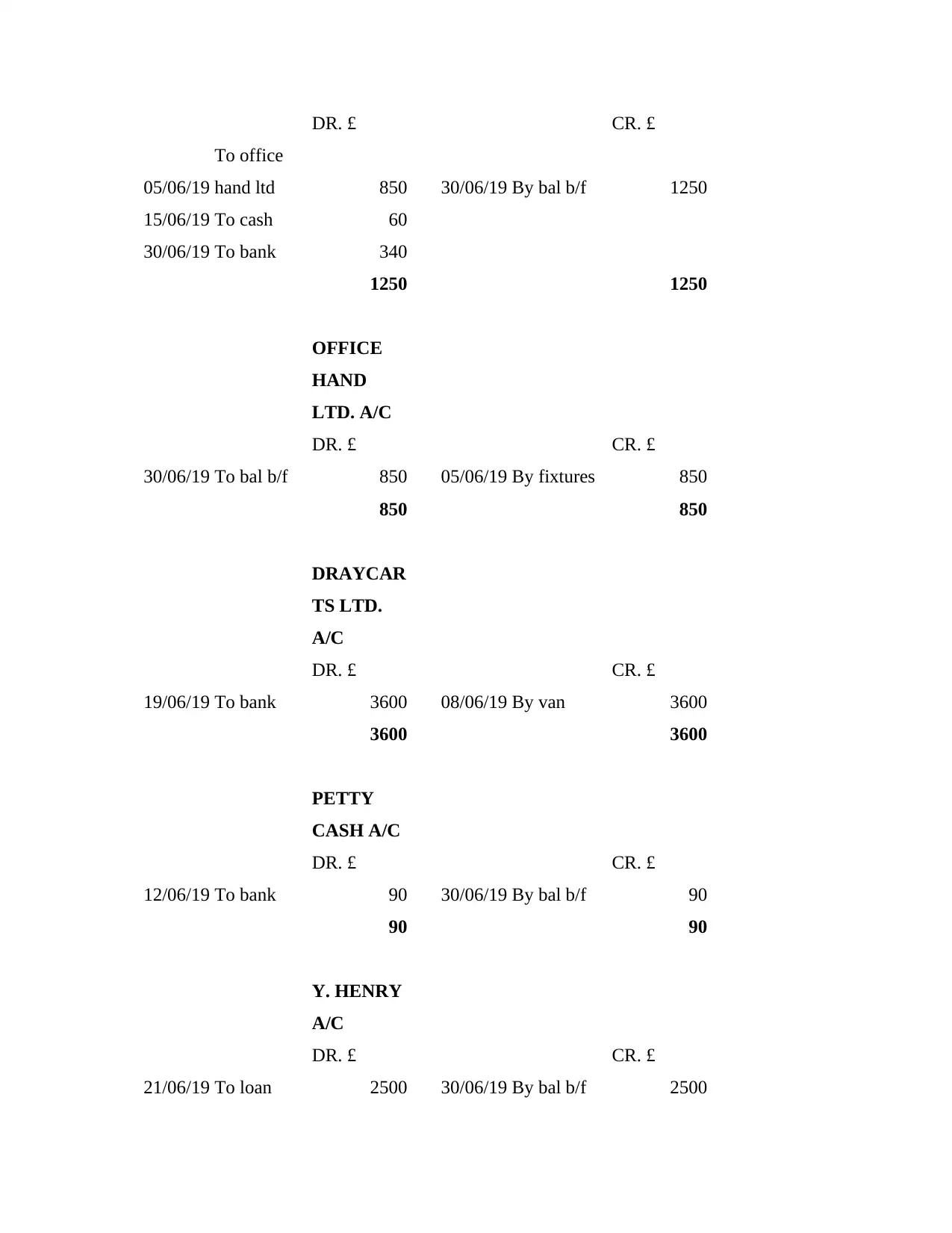
DR. £ CR. £
05/06/19
To office
hand ltd 850 30/06/19 By bal b/f 1250
15/06/19 To cash 60
30/06/19 To bank 340
1250 1250
OFFICE
HAND
LTD. A/C
DR. £ CR. £
30/06/19 To bal b/f 850 05/06/19 By fixtures 850
850 850
DRAYCAR
TS LTD.
A/C
DR. £ CR. £
19/06/19 To bank 3600 08/06/19 By van 3600
3600 3600
PETTY
CASH A/C
DR. £ CR. £
12/06/19 To bank 90 30/06/19 By bal b/f 90
90 90
Y. HENRY
A/C
DR. £ CR. £
21/06/19 To loan 2500 30/06/19 By bal b/f 2500
05/06/19
To office
hand ltd 850 30/06/19 By bal b/f 1250
15/06/19 To cash 60
30/06/19 To bank 340
1250 1250
OFFICE
HAND
LTD. A/C
DR. £ CR. £
30/06/19 To bal b/f 850 05/06/19 By fixtures 850
850 850
DRAYCAR
TS LTD.
A/C
DR. £ CR. £
19/06/19 To bank 3600 08/06/19 By van 3600
3600 3600
PETTY
CASH A/C
DR. £ CR. £
12/06/19 To bank 90 30/06/19 By bal b/f 90
90 90
Y. HENRY
A/C
DR. £ CR. £
21/06/19 To loan 2500 30/06/19 By bal b/f 2500
⊘ This is a preview!⊘
Do you want full access?
Subscribe today to unlock all pages.

Trusted by 1+ million students worldwide
1 out of 18
Related Documents
Your All-in-One AI-Powered Toolkit for Academic Success.
+13062052269
info@desklib.com
Available 24*7 on WhatsApp / Email
![[object Object]](/_next/static/media/star-bottom.7253800d.svg)
Unlock your academic potential
Copyright © 2020–2025 A2Z Services. All Rights Reserved. Developed and managed by ZUCOL.





